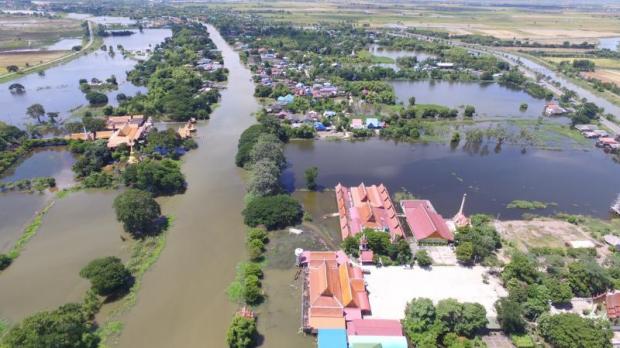
The recent floods across several provinces have inundated business districts and farm areas and will have a short-term impact on the agricultural and food processing sectors, say government and industry officials.
But the floods are unlikely to cause severe damage or diminish the productivity of large factories, particularly those in low-lying areas whose structures were bolstered after the severe floods of 2011.
Torrential rainfall made dams overflow in the northern and northeastern regions, forcing the Royal Irrigation Department to discharge water from dams and flood central areas of Thailand, including Bangkok.
Following with the low-pressure storm Khanun, Thailand is bracing for more floods that could disrupt the recovering economy.
The Royal Irrigation Department discharged water from dams at up to 2,600 million cubic metres per second, up from the normal rate of 2,000 million cubic metres per second, causing immediate knee-high floods in several zones in central provinces. Some low-lying areas faced chest-high flooding.
The Department of Disaster Prevention and Mitigation reported that the floods have hit 10 provinces so far, killing three people and impacting 55,814 families.
Some 3 million rai of farmland and around 12,000 rai of fishery farms were destroyed and 72,693 cattle and livestock were killed or missing.
Hundreds of factories in Ayutthaya, which were hit the worst in the 2011 floods that cost up to 1.4 trillion baht in economic damage, are expected to be safe, according to Chen Namchaisiri, chairman of the Federation of Thai Industries (FTI).
"We experienced the worst flooding in 2011 and since then we have been well-prepared for floods," Mr Chen said.
He said business are aware that there will be a flood to the specific areas, and alongside with water management from the government, factories will carry their own flood management plans.
"What we want is a clear policy from the government on how the flooding can be managed and how long it will last," Mr Chen said.
Amara Charoengitwattangun, director of SET-listed developer Rojana Industrial Park Plc in Ayutthaya, said the flooding is expected to damage transport and businesses in cities, but the industrial park and factories are unlikely to be destroyed or face disruptions.
The damages in the farm sector are expected to cause disruptions for the food and food processing segments, which generate nearly 1 trillion baht of export value annually.
The exact financial damage the food sector will face is unknown as agencies have not yet made the calculations, but initial damage is expected to be limited.
FTI food processing industry club president Boonpeng Santiwattatam said the club expects to see certain damage to crops and livestock that are raw materials for the food processing sector.
Since the floods are limited to certain low-lying areas in central provinces, the damage is also limited to some crops.
Rice and other key commodities are also expected to remain unaffected, with the Agriculture Ministry maintaining the forecast for the rice crop due to be harvested in late October at 25 million tonnes.
"Rice crops can survive being underwater for a few weeks, so at this stage we do not anticipate any major damage to rice crops if the flooding does not last longer than a few weeks," said an official at the Agriculture Ministry.
In contrast, the flood water is seen as a boon to rice production as it is expected to help increase the production of premium-grade rice grown in plateau areas, according to Charoen Laothamatas, president of the Thai Rice Exporters Association.